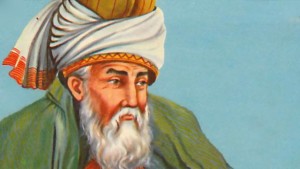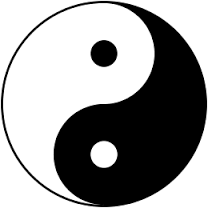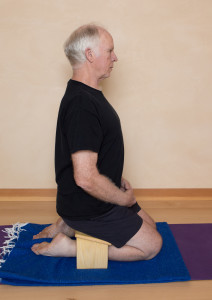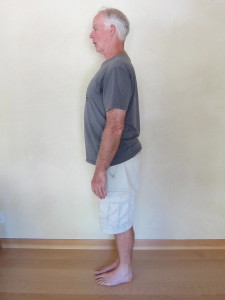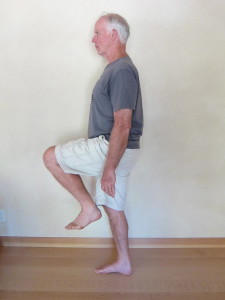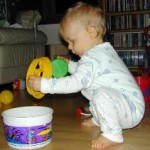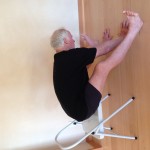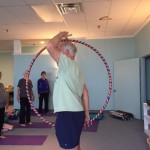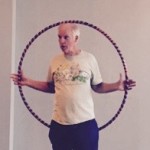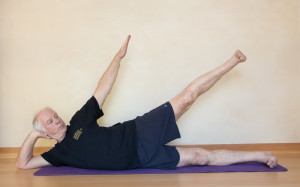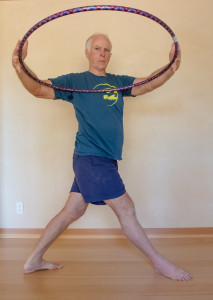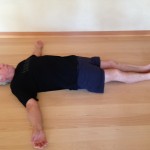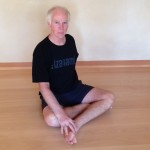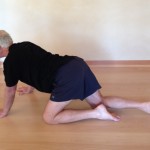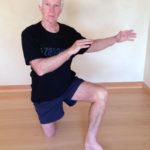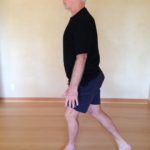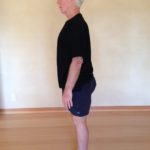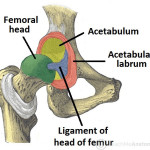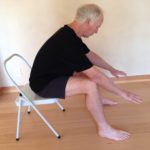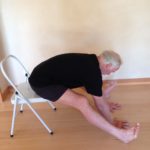Included:
Embodied Conscious Awakening; Basic Goodness / Bodhicitta / drashtuh svarupe
Using the Micro-cosmic orbit in meditation, breathing and asana.
Saying yes and no at the same time.
Basic Taoist Principles:
Unity of Macro-cosmic and Micro-cosmic levels. As humans we reflect the harmony of the heavenly movements of stars, planets, moon, and weather in the human system. Healing is returning again and again to a state of harmony with the whole of creation.
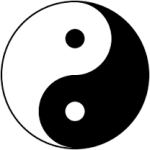 From a spiritual perspective however, we are the “whole” and are never ‘out of balance’. Our basic goodness/bodhicitta/drashtuh svarupe, with its two faces of ‘radical emptiness and unconditional love, is untouchable by the slings and arrows of outrageous fortune. Thus arises the spiritual paradox everyone on the spiritual path encounters. Not practicing does not affect your basic goodness, nor does practicing. So if how you feel about your self goes up and down like a political poll, based on the quality of your practice, or your life in general, you have drawn a wrong conclusion about yourself, (sutra I-6 viparyaya, sutra I-30 – bhranti darshana). The Atman, True Self, Buddha Nature, or whatever other words we may use to point to our innate perfection, is universal and unassailable. But if we don’t feel this, know this, we create lots of suffering. And, in our non-dual reality, we also still have much to learn and layers and levels of evolution ahead of us. (We’ll pick this idea up again in the Yes/No section that follows.)
From a spiritual perspective however, we are the “whole” and are never ‘out of balance’. Our basic goodness/bodhicitta/drashtuh svarupe, with its two faces of ‘radical emptiness and unconditional love, is untouchable by the slings and arrows of outrageous fortune. Thus arises the spiritual paradox everyone on the spiritual path encounters. Not practicing does not affect your basic goodness, nor does practicing. So if how you feel about your self goes up and down like a political poll, based on the quality of your practice, or your life in general, you have drawn a wrong conclusion about yourself, (sutra I-6 viparyaya, sutra I-30 – bhranti darshana). The Atman, True Self, Buddha Nature, or whatever other words we may use to point to our innate perfection, is universal and unassailable. But if we don’t feel this, know this, we create lots of suffering. And, in our non-dual reality, we also still have much to learn and layers and levels of evolution ahead of us. (We’ll pick this idea up again in the Yes/No section that follows.)
Yin and Yang are a unity: never separate from each other, but complementary, not oppositional. (Yin/Yang compared to gunas; (non-dual vs dual). In Samkya, tamas and rajas are seen as separate from each other and undesirable in themselves. Only in the third quality, sattva, do they find a transitory harmony.
When healthy, excess yin transformed into yang, excess yang transformed into yin
Healthy Yang: action flows from clear perception in present moment
Healthy Yin: Receptive, alert, present
When unhealthy, energy gets blocked: deficient yin or yang, excess yin or yang
Unhealthy yin: passive, depressed, unstable, damp/wet/soggy
Unhealthy yang: aggressive, un-co-operative, up-rooted, dissociated
Yin/Yang of Radical Awakening: Emptiness and Love
Love: Heart as portal
Yin/Yang as giving and receiving
Yin Love: Heart receiving love flowing in from the whole
Yang Love: Being a source of Love flowing out to the whole
Yin/Yang Love: allowing both to ‘just be’ as dynamic state
Yin/Yang as Heaven and Earth, crown and root chakras as gates/portals
emergence of center line/median line/chakra line, notocord/primitive streak
Yin/Yang as front and back, endoderm and ectoderm, flexion/extension,
fwd bends/back bends
Yin/Yang as lateral flexion/extension: on side (anantasana), or trikonasana and related poses.
Yin/Yang as right and left, ha and tha, ida and pingala, bilateral symmetry
Yin/Yang as radial expanding/condensing, centripetal/centrifugal forces
Yin/Yang as Emptiness (no, I am not this) and Love (yes, I am this) saying yes to the most horrible things you can imagine about yourself, not just the good stuff.
YES/no and NO/yes
The non-dual vision of Taoism offers us an infinite number of ways in which the unity of duality can express itself. A very important one is the notion of Yes/No as Yin/Yang, a paradoxical integration of what appear to be opposing perspectives. The two faces of spiritual awakening are radical emptiness ( the path of ‘no’), and unconditional love (the path of yes). Dive deeply into one and you discover the other. they are inseparable.
Saying yes to the inner world is the subject of the famous poem by the Sufi mystic Rumi, ‘The Guest House’, here translated by Coleman Barks.
This being human is a guest house.
Every morning a new arrival.
Welcome and entertain them all!
Even if they’re a crowd of sorrows,
who violently sweep your house
empty of its furniture,
still treat each guest honorably.
He may be clearing you out
for some new delight.
The dark thought, the shame, the malice,
meet them at the door laughing,
and invite them in.
Be grateful for whoever comes,
because each has been sent
as a guide from beyond.
Saying yes to our repressed emotions and other scary and unpleasant aspects of the unconscious brings them into the light. Of course, the challenge is then to say ‘no’ to getting entangled in them, feeding them with energy, or actually believing their story. Rumi’s poem is used as a guide in Mindfulness practice, where spacious open attention is held as the mental phenomena are allowed to arise and then dissipate. The deep seated, well entrenched pathologies and traumas will likely need the professional support of a well trained therapist, but the everyday silliness can be worked with on your own.
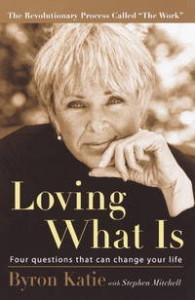 The path of ‘Yes/no’ is the ultimate expression of unity and wholeness. To be fully alive, to be fully awake, is to say ‘yes’ to everything and anything life throws our way, whether arising from within or without. Ojai’s own Byron Katie uses this principle as the core her teaching, known as ‘The Work’, and described in her first book, Loving What Is’. As she learned, “when I argue with reality, I lose, 100% of the time!” She is talking about all levels of reality, from politics and weather, to our own mental output.
The path of ‘Yes/no’ is the ultimate expression of unity and wholeness. To be fully alive, to be fully awake, is to say ‘yes’ to everything and anything life throws our way, whether arising from within or without. Ojai’s own Byron Katie uses this principle as the core her teaching, known as ‘The Work’, and described in her first book, Loving What Is’. As she learned, “when I argue with reality, I lose, 100% of the time!” She is talking about all levels of reality, from politics and weather, to our own mental output.
As this is a non-dual vision, saying yes to all of reality does not preclude saying ‘no’ to specific choices available for our actions. Yes, I want to see my unconscious habits and patterns, as painful as they may be. Then I can so ‘no’ to any actions that come from those self-centered egoic mind states. Like parenting, we can say yes to the absolute innate divinity of our children, and, at the same time, still say ‘no’ to behavior that is not acceptable.
If you want to try an advanced practice, work with our current president. See his basic goodness. See him as a ‘child of God’ with innate Buddha Nature, as one might say, and simultaneously strongly condemn his words and behavior. Being for Love, Peace, Accountability, Maturity, Compassion, Wisdom is primary. This way we are constantly injecting love and light even as we criticize the pathology. This promotes healing. Being primarily ‘against’ invites dualistic separation and creates an unbridgeable gap in society. Our own anger needs to be transformed into positive social action, not more negativity, and certainly no more whining!
The path of “No’ or neti neti, ( not this, not this) is another vehicle of awakening, used in Vedanta. Here, we develop a ‘witnessing consciousness’ that begins to notice; I can be aware of my body, therefore I am not the body. I can be aware of my thoughts, therefore I cannot be my thoughts. In fact, anything that arises in my awareness cannot be me, because I am the witness to what arises. eventually, even the ‘witness’ drops until just ‘Pure Awareness’, the Seer’ remains. When we ‘See’ this vast, open spaciousness gives birth to all of life and then a resounding ‘yes’ emerges from the depth of no.
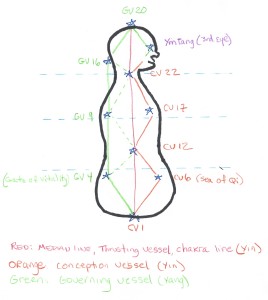 Using the Micro-Cosmic Orbit Chart
Using the Micro-Cosmic Orbit Chart
The chart displays four primary modes of exploration: 1. the specific points listed; 2. the three primary vessels (energy lines) (and there is a fourth we will get to later); 3. the three volumes (diamond shapes in the diagram) known as ‘dantiens‘: and three regions of the torso, from CV-22 to CV-1, aka the ‘three burners. This framework, a few practices and your own imagination will provide you with homework for the rest of your life, should you be so inclined! Take it one point, one vessel, one volume at a time.
The micro-cosmic orbit completes a circuit, linking the orange  and green lines as seen in the next illustration. The green line, known as the Governing Vessel, is the primary Yang channel, emerging from the ectoderm in embryology, and primarily involves interactions with the outer world. (Remember yang always contains yin and vice versa.) It begins at a point between the coccyx and anus, travels up the back, through the crown chakra, (GV-20 above) and ends at the top of the mouth.
and green lines as seen in the next illustration. The green line, known as the Governing Vessel, is the primary Yang channel, emerging from the ectoderm in embryology, and primarily involves interactions with the outer world. (Remember yang always contains yin and vice versa.) It begins at a point between the coccyx and anus, travels up the back, through the crown chakra, (GV-20 above) and ends at the top of the mouth.
The Orange line is the Conception Vessel, primary yin, emerging from the endoderm and involves the inner world, primarily. It begins on the center of the perineum, continues up the front body and ends up under the bottom lip. The two link up to create a single circuit that supports all the other 12 meridian lines in the body. Interestingly enough, the the two points meet and break at the two ends of the gut body, the mouth and anus. At birth, with the respiratory and digestive systems finally open up to the outer world, the vessel becomes constantly challenged to stay connected.
Meditation Practice 1. Sitting in a comfortable position, adjusting front to back and side to side on the sitting bones until you find your center, feel your median line extending through your core connecting the body to heaven and earth through crown (GV-20) and root (CV-1) chakras. This is the ‘Thrusting Vessel’ and creates the blueprint of the body in Chinese Medicine. This comes right from embryology as the primitive streak and notocord. Feel the balance of weight (yin/ground) and lightness (yang/sky). Feel the Yang fire energy from the heavens descending down to meet the yin/water element at CV-1. Feel the water energy arising up from the earth, through CV-1 and ascending to meet the fire energy at GV-20. Feel Yin/water and Yang/fire intermingling as the healthy flow of qi in the entire body. Let this feeling support the pose and rest in the stillness at the core of being.
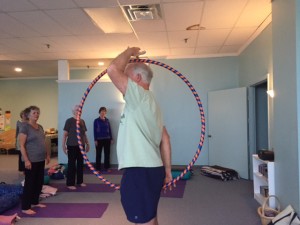 Meditation Practice 2. Same position, visualize the circle. Here we can add that there are three layers of the points: along the field, as shown by the hula hoop; along the surface of the body, where the needles go, and inside the body, where the inner qi is engaged. Our meditation works well on the outer ring.
Meditation Practice 2. Same position, visualize the circle. Here we can add that there are three layers of the points: along the field, as shown by the hula hoop; along the surface of the body, where the needles go, and inside the body, where the inner qi is engaged. Our meditation works well on the outer ring.
Bring your attention the the seat of the yin, CV-1, the center of the perineum. (root and crown chakra points will be on the body.) Breathe in and out through this point. Observe how it moves as the inhalation and exhalation come and go. Then choose either CV-6 on the front, or GV-4 at the back, and connect to CV-1. Inhale into the perineum, let the exhalation travel on an arc to the next point. Inhale into that point and let the exhalation travel back along the arc to CV-1. Next breath, repeat with the opposite point, and eventually trace the breath on an arc from from to back always passing through CV1. (like riding the half pipe in snow boarding!) You can also reverse the breath, exhaling into CV-1 and inhaling into the other points. CV-1, the seat of the yin/water is a very important place to establish and stabilize the grounding of the body.
Meditation Practice 3. Same as two only now add new points, one on the front, one on  the back. You can go right from CV-1 to GV-9 and CV-17, or you can include GV-4 and CV-6 on your travels. No rigid rules, just exploring the points along the circle, until you can also pass though GV 20 at the top. A clock face can be helpful in locating points and spaces. Imagine a pie sliced into 12 sections. Feel the shape of each section. Many will be compressed, collapsed, twisted, etc. Use you imagination to even out the sections. No need to use muscular energy. Just feel expansion and opening (yang) and receiving (yin).
the back. You can go right from CV-1 to GV-9 and CV-17, or you can include GV-4 and CV-6 on your travels. No rigid rules, just exploring the points along the circle, until you can also pass though GV 20 at the top. A clock face can be helpful in locating points and spaces. Imagine a pie sliced into 12 sections. Feel the shape of each section. Many will be compressed, collapsed, twisted, etc. Use you imagination to even out the sections. No need to use muscular energy. Just feel expansion and opening (yang) and receiving (yin).
Asana Practice 1: In tadasana, find the micro-cosmic orbit and feel the space between your body and the imaginary circle. Feel the qi in that space. Use the clock to find hours that may be collapsed or over inflated. Be as even as possible in your imagination and allow the breath to support the fullness and evenness. Remember, we are all distorted in our fields, so perfection is not the goal. Just curiosity and playfulness. Feel how the skin, flesh and fluids respond to your imagination and intention.
Now slowly come into uttanasana and notice what happens the the field (the whole volume of space surrounding the body, your breath, the skin, the bones, everything. Reverse back to tadasana observing how the integrity of your field changes.
Asana Practice 2: Lets add K-1. In tadasana, feel the weight of the body engaging K-1 on the soles of your feet. This is the first point on the kidney meridian, known as the bubbling spring, or where the water element begins to rise up from the earth, like a spring in the ground. The kidneys are the most ‘yin’ of the yin organs and govern water, so these points are crucial in awakening the fluid body’s intelligence. Once you can feel them (move around if necessary), connect them to CV-1, the seat of the yin, to link your root to the earth. Walk around some and feel the action of K-1 as you move. Eliminate any tension and just move by sustaining the flowing qi through the earth, the surrounding space and your body.
Now, when you you try uttanasana, sustain the flow through K-1 all the way through. this should help the field (and the body) stay more open.
Asana Practice 3. Let’s add the tail. Our human tail is rooted in the pelvic floor, to keep the organs from falling out in our predominantly upright life style. In your imagination, add an animal tail of any sort and let it extend like a party favor. In tadasana, let it be as long as your legs and feel its presence near the inner heels. (we will use the inner heels later in trikonasana and wide distance poses. When going into uttanasana, retain the micro-cosmic orbit, K-1 on each foot, and now the long tail. (Juggling for yogis!) The field will be stronger and over time more and more effortless. There will be less fighting with tight muscles and more just opening into space.
Asana Practice 4: Trikonasana: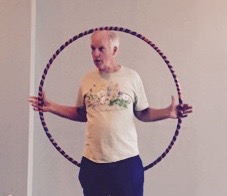
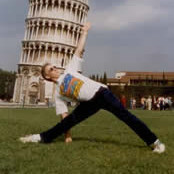 We now rotate the micro-cosmic orbit 90 degrees to open the lateral plane. This engages the gall bladder meridian and helps integrate front and back bodies where the meet at the sides of the torso and legs. Add K-1, your imaginary tail, the inner back heel to open the true coccyx, and press the inside edge of the back foot (without collapsing the ankle or arch!!) like a skier carving an edge in a sharp turn. This energy flow will release the spinal energy even further, opening the field. (Same principle for parsvakonasana and ardha chandrasana.) Your torso should feel like a wind sock at an airport with a steady breeze.
We now rotate the micro-cosmic orbit 90 degrees to open the lateral plane. This engages the gall bladder meridian and helps integrate front and back bodies where the meet at the sides of the torso and legs. Add K-1, your imaginary tail, the inner back heel to open the true coccyx, and press the inside edge of the back foot (without collapsing the ankle or arch!!) like a skier carving an edge in a sharp turn. This energy flow will release the spinal energy even further, opening the field. (Same principle for parsvakonasana and ardha chandrasana.) Your torso should feel like a wind sock at an airport with a steady breeze.
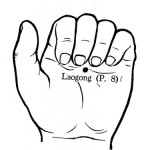 Asana Practice 4. Flipping the dog: (not the same as flipping the bird!) There is a point on the hand that is
Asana Practice 4. Flipping the dog: (not the same as flipping the bird!) There is a point on the hand that is 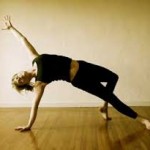 analagous to K-1 on the feet, known a Pericardium 8 or P-8.We will use these points in dog pose to open and ground the upper limbs and keep the neck and shoulders form tightening up in weight bearing. Establish a strong down dog, and then lift and extend one leg into one legged dog. Fun a fun experience, lift the opposite hand off the floor to come into the contra-lateral dog. Balance is tricky here. To flip the dog, return to the one legged dog, bend the top leg and begin to rotate the pelvis like ardha chandrasana. As the pelvis reaches 90 degrees, anchor your attention in your coccyx to sustain the height of the pelvis as you rotate more and the leg lowers. Lift the arm and float the foot off the floor for a bit for balance and upon landing deeply extend the entire body. Reverse the steps to return to down dog.
analagous to K-1 on the feet, known a Pericardium 8 or P-8.We will use these points in dog pose to open and ground the upper limbs and keep the neck and shoulders form tightening up in weight bearing. Establish a strong down dog, and then lift and extend one leg into one legged dog. Fun a fun experience, lift the opposite hand off the floor to come into the contra-lateral dog. Balance is tricky here. To flip the dog, return to the one legged dog, bend the top leg and begin to rotate the pelvis like ardha chandrasana. As the pelvis reaches 90 degrees, anchor your attention in your coccyx to sustain the height of the pelvis as you rotate more and the leg lowers. Lift the arm and float the foot off the floor for a bit for balance and upon landing deeply extend the entire body. Reverse the steps to return to down dog.
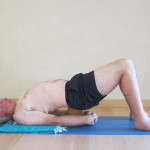 Asana Practice 5. Double Action in the Pelvis opening the groins through the sacrum, hips and the CV-1 connections.
Asana Practice 5. Double Action in the Pelvis opening the groins through the sacrum, hips and the CV-1 connections.
Using a block or bolster for support, lightly ground K-1 through the feet and center the pelvis. Try these two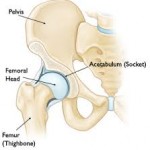 movements; (bottom of the groin is everything below the femur head; top of the groin is everything above the femur head) bottom of the groins dropping to the coccyx side of the block for the forward bending, internally rotating, untucking, CV-6 to CV-1 action; top of the groins dropping on the navel side of the block, for the hip extending, externally rotating, tucking, GV-4 to CV-1 action. Now do both at the same time by using energy and imagination so you feel as if the sacrum is floating in space and the pelvis is floating over the femur heads. Sort of…..
movements; (bottom of the groin is everything below the femur head; top of the groin is everything above the femur head) bottom of the groins dropping to the coccyx side of the block for the forward bending, internally rotating, untucking, CV-6 to CV-1 action; top of the groins dropping on the navel side of the block, for the hip extending, externally rotating, tucking, GV-4 to CV-1 action. Now do both at the same time by using energy and imagination so you feel as if the sacrum is floating in space and the pelvis is floating over the femur heads. Sort of…..
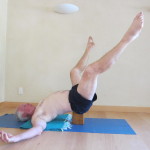
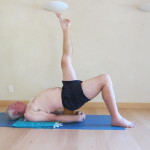 Once you have a feel of the double action, try with one leg extended into the air, and then both. Keep the lower spinal muscles relatively soft, so the energy flow sustains the posture, not tension.
Once you have a feel of the double action, try with one leg extended into the air, and then both. Keep the lower spinal muscles relatively soft, so the energy flow sustains the posture, not tension.
Asana Practice 6: Spirals Around the Median Line
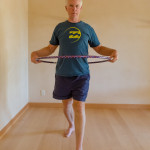 We have used three ‘vessels’ so far; the yin conception vessel and the yang governing vessel which comprise the micro-cosmic orbit, and the median line connecting root and crown chakras known as the yin ‘thrusting vessel’. The yin thrusting vessel has a yang
We have used three ‘vessels’ so far; the yin conception vessel and the yang governing vessel which comprise the micro-cosmic orbit, and the median line connecting root and crown chakras known as the yin ‘thrusting vessel’. The yin thrusting vessel has a yang 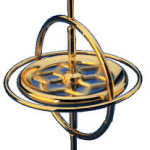 complement called the girdling vessel which circles the lower body around the lower dantien perpendicular to the other three. Think of it as a latitude line, or the horizontal component of a gyroscope. Its spreading action parallel to the earth (when sitting or standing) stabilizes the body and we can explore and utilize this girdling action in twisting poses. Most students contract to muscles in a twist, hit a barrier of resistance and then fight against this to push the edges of the pose. What if the action was to move outward from the center in centrifugal expansion so you create more space rather than less. Of course this is a field action, not a structural one, so your imagination needs to invite the energy flow to move this way.
complement called the girdling vessel which circles the lower body around the lower dantien perpendicular to the other three. Think of it as a latitude line, or the horizontal component of a gyroscope. Its spreading action parallel to the earth (when sitting or standing) stabilizes the body and we can explore and utilize this girdling action in twisting poses. Most students contract to muscles in a twist, hit a barrier of resistance and then fight against this to push the edges of the pose. What if the action was to move outward from the center in centrifugal expansion so you create more space rather than less. Of course this is a field action, not a structural one, so your imagination needs to invite the energy flow to move this way.
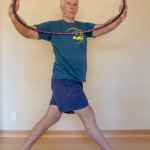 By using a hula hoop for both tactile and visual effects, we can begin to feel some new possibilities in the spiraling field of the twisting poses. The simple standing twist is the easiest place to start. Stay grounded in K-1, both feet, and allow the spiral to rise up as the pelvis begins to receive the action. By holding the hoop this way imagine the body getting wider as the spiral ascends, creating space around and between the bones, muscles and organs. Also, because of the hoop, we are utilizing another double action. We are also activating both directions of rotations at the same time, even as one dominates. In the example above, I am rotating to the right with my gross body (muscles and bones) but the dynamic action of my right arm looping in the opposite direction engages the fluid body to feel both spirals. My limit is when I begin to lose this ‘hidden’ opposite action. I pause and wait for yin and yang to find a new balance point, ‘sustaining’ the pose in a state of vibrant stillness. This is sthira sukham asanam, meditation in action, samyama in asana.
By using a hula hoop for both tactile and visual effects, we can begin to feel some new possibilities in the spiraling field of the twisting poses. The simple standing twist is the easiest place to start. Stay grounded in K-1, both feet, and allow the spiral to rise up as the pelvis begins to receive the action. By holding the hoop this way imagine the body getting wider as the spiral ascends, creating space around and between the bones, muscles and organs. Also, because of the hoop, we are utilizing another double action. We are also activating both directions of rotations at the same time, even as one dominates. In the example above, I am rotating to the right with my gross body (muscles and bones) but the dynamic action of my right arm looping in the opposite direction engages the fluid body to feel both spirals. My limit is when I begin to lose this ‘hidden’ opposite action. I pause and wait for yin and yang to find a new balance point, ‘sustaining’ the pose in a state of vibrant stillness. This is sthira sukham asanam, meditation in action, samyama in asana.
Breathing Explorations:
Lower Dantien Breathing
Lie on the floor with your knees bent and your feet on the floor so you can feel the K-1 connections. Adjust your pelvis and sacrum so they are neutral, as in the above exploration on the block. Slowing allow the breath to fill the lower body, as if the area from the navel to the pelvis is expanding on the in breath and condensing on the out breath. 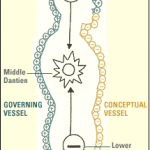 Observe how CV-1 moves with the breath. continue for several minutes, feeling the insides and outsides of the pelvis softening to receive the breath.
Observe how CV-1 moves with the breath. continue for several minutes, feeling the insides and outsides of the pelvis softening to receive the breath.
Now create a two part breath. Inhale into pelvis as above and when full, pause, and then expand the breath further into the region between the navel and the diaphragm. then soft exhalation. Feel the difference in this part of the body, the upper abdominal versus the lower abdominal. Repeat gently for several cycles or minutes.
Now add the third section, the chest/middle dantien region. Let it expand from the support of the lower two sections. This may feel like a three part Viloma breath, with subtle pauses, but feel how the lower dantien anchors the breath in all three sections. Eventually add the limbs, so they can partake in the oxygenation of the cells.
Blood Breathing:
I made this one up during my swimming somatic meditations. Here, we feel that the blood flow is also aided by our breath. As we inhale, there is an expanding negative pressure that pulls air into the chest and lungs. This negative pressure also draws blood the the heart and lungs. As you inhale, using the lower dantien as the anchor, visualize the blood flowing up into the heart and out into the lungs where it meets the air. As you exhale, visualize the blood flowing back to the heart from above, but also being squeezed by the abdominals from below, traveling up the the heart and out to the lungs. The net result is the sense of sustaining the up flow of the water element, in the form of blood here, as a continuous field of lightness. In TCM, the fire transforms the water to mist so that it rises and cures ‘dampness’.


